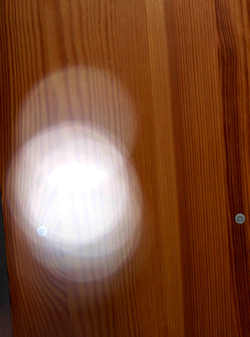Orbs: alternative theories

Moving orbs
Sometimes pictures appear to show orbs moving, like the one below. On closer inspection, the 'moving' orb is actually a tight cluster of orbs overlapping each other. Such a cluster could be caused by several particles of dust (or water droplets) that happen to be close together. However, it is more likely to be caused by a larger object, such as a big dust fibre* or a small insect. Such an object will appear large enough to the camera to have several highlights. It is the highlights that show up as the overlapping orbs.

Sometimes two photos taken in quick succession appear to show a single orb having moved between frames. This is sometimes taken as indicating a paranormal origin. However, there are several objections to this interpretation. Firstly, dust moves! So it could indeed be the same orb but still produced by dust. Secondly, and more likely, the 'moved' orb is actually produced by a different particle of dust. The orb zone is very small so different bits of dust float into and out of it all the time. It would be very difficult to identify an individual orb. Orb shape, size, colour and structure tend to depend on the camera and the conditions, so different ones will often look similar from frame to frame in a single session.
Though the Orb Zone Theory of orbs fits the available data extremely well, alternative explanations still persist (which is typical of paranormal phenomena). It is no surprise that there are many theories involving ghosts and spirits. What is stranger is the number of alternative natural explanations. Here is a selection.
Dust on the lens
It is sometimes stated that orbs are caused by dust on the lens of the camera. Therefore, the argument goes, if you keep your camera lens dust-free the only orbs you'll get will be paranormal!
Photographers certainly like to keep their lenses dust free. However, excess dust shows up as overall lack of sharpness in the photograph. It is certainly not possible to make out individual particles of dust as they are far too close to be seen (much closer than the orb zone).
Sensor fault
Some people have suggested that digital camera sensor faults could be responsible for orbs. Luckily, sensor faults are very rare in digital cameras, far rarer than orbs. Certainly, anyone who gets 'orbs' in the same place on the frame of every photo should return the camera to wherever they bought it!
Image processing
It has also been suggested that the way sensors collect and compress data can produce orbs. However, such digital artifacts, are typically linear (eg. 'blooming') or rectangular rather than circular and much smaller (a few pixels) than many orbs. In addition, orbs can be produced with film cameras with no sensors.
Infra-red sensitivity
See here for details of this frequently repeated myth. If you point a TV remote at a digital camera and press a button on it, you will see a light caused by the infra-red used to control the TV. However, this does not mean the camera is particularly sensitive to infra-red. Try taking a photo with an infra-red filter on your camera and the chances are you will get nothing unless you deliberately set it to a high ISO (sensitivity) setting and overexpose by many F-stops. Even then you'll probably need strong sunlight to get anything much and flash will produce nothing on its own. In ordinary photos any infra-red light would be completely drowned out by ordinary light. Digital cameras are typically 1000x more sensitive to light than infra-red.
Orbs with tails
Sometimes people get photos of orbs with tails resembling tiny comets. These would appear to be moving orbs and indeed they are. See orbs with tails.
Applying science to orbs
The Orb Zone Theory presents a case study of how the scientific method can be applied to paranormal phenomena.
Orbs and EMF meters
Some people maintain that orbs are genuinely paranormal when their appearance coincides with interesting electromagnetic activity (measured with an EMF meter). This seems to rely on the assumptions that (a) orbs are related to ghosts and that (b) ghosts are associated with electromagnetic fields. As explained elsewhere, the evidence for a supposed connection between ghosts and electromagnetic fields is somewhere between anecdotal and non-existent (except for weak, complex magnetic fields).
Of course, if anyone has any evidence of a connection between orbs and electromagnetic fields, it would be great if you got in touch. It is difficult to see what the connection might be but in science evidence is always paramount.
It wasn't dusty!
Investigators are often advised to avoid dusty environments to reduce 'false' orbs. The implication is that in pristine areas any orbs photographed must be genuinely paranormal.
The problem here is that few of us are really aware how dusty a place is unless we can see the stuff. Generally it takes a powerful beam of light to make dust apparent. Dust is, however, present all the time whether you can see it or not. It requires specialised equipment to make a dust-free environment.
What's more, investigators will stir up more dust into the atmosphere just by moving around. Heat sources (including humans) will also put more dust into the air. Dust is also moved around by static electricity.
So all those precautions against dust are pretty much pointless. You should assume it is dusty everywhere and the dust theory can NEVER be discounted from explaining orbs.